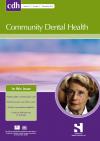Community Dental Health

- Cover Date:
- December 2015
- Vol:
- 32
- Issue:
- 4
Time trends and determinants of acute odontogenic maxillofacial infections in Lithuania: a retrospective national 2009-2013 treatment data audit
Objectives: To examine the distribution of treatment facilities accepting patients with acute odontogenic maxillofacial infections (AOMIs),
time trends in incidence and relate these infections with a number of determinants. Methods: A national Lithuanian retrospective study
gathered data on all patients treated in outpatient/inpatient treatment facilities. Adjusted Incidence Ratios (AIRs) of AOMIs were calculated
separately for each type of infection and for each year. Administrative districts (ADs) were grouped into low, medium, and high thirds based
on the regional determinants: socio-economic index (R-SEI), access to basic (R-BDCI) or specialized dental care (R-SDCI) and index of
systemic diseases (R-ISD). Results: There were no statistically significant geographical differences in the distribution of TFs providing care
for patients with AOMIs. Numbers of treatment facilities consistently increased from 2009 to 2013, but there was no consistent increase/
decrease in the incidence of AOMIs (~1%). Regions with the highest R-SEI tended to have a higher incidence of AOMIs as compared to
regions with medium or low R-SEI. When controlled for other determinants, lower R-BDCI∕R-SDCI scores were associated with a higher
incidence of AOMIs. Conclusions: High annual incidences (~1% of a total population) were diagnosed and treated for AOMIs, but there
was no consistent time trend for these infections.
Key words: dental, acute, odontogenic infections, health care disparities, Lithuania
- Article Price
- £15.00
- Institution Article Price
- £
- Page Start
- 209
- Page End
- 215
- Authors
- R. Rastenienė, J. Aleksejūnienė, A. Pūrienė
Articles from this issue
- Title
- Pg. Start
- Pg. End
- The feasibility of using an alcohol screening tool in a UK dental setting to identify patients’ alcohol consumption
- 196
- 198
- Long term evaluation of the clinical effectiveness of community milk fluoridation in Bulgaria
- 199
- 203
- Time trends and determinants of acute odontogenic maxillofacial infections in Lithuania: a retrospective national 2009-2013 treatment data audit
- 209
- 215
- Dental anxiety and oral health in 15-year-olds: a repeated cross-sectional study over 30 years
- 221
- 225
- Development and evaluation of a Dental Patient Feedback on Consultation skills (DPFC) measure to enhance communication
- 226
- 230
- A retrospective audit of population service access trends for cleft lip and cleft palate patients
- 237
- 240
- Caregiver financial distress, depressive symptoms and limited social capital as barriers to children’s dental care in a midwestern county in the United States
- 252
- 256
